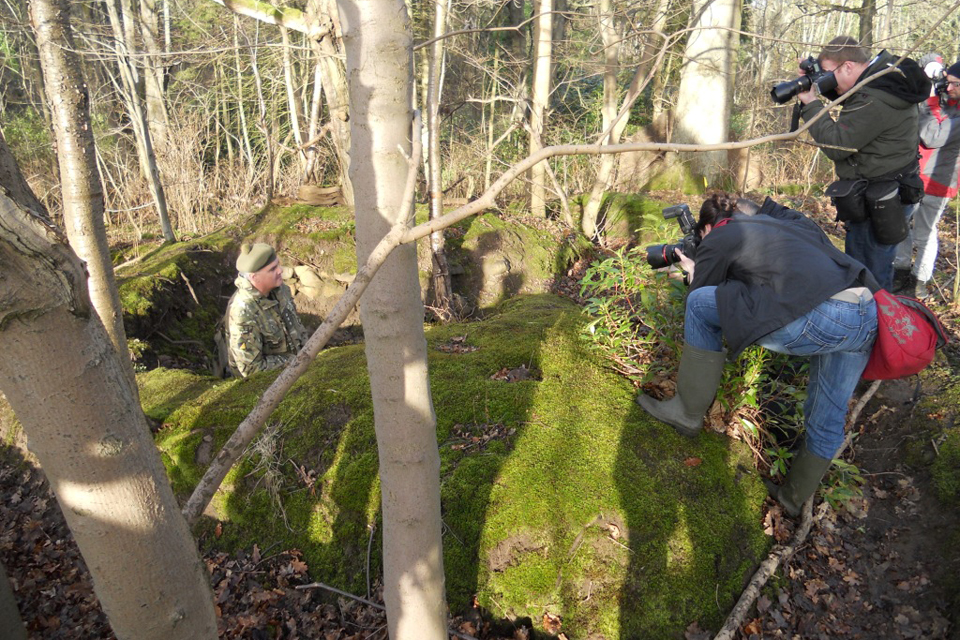Trenches survey prompts preservation calls
Findings from an archaeological survey of First World War practice trenches in Edinburgh have prompted calls for their preservation.
![Colonel Phil Bates tagging areas of interest at the Edinburgh site (library image) [Picture: Mark Owens, Crown copyright]](https://assets.publishing.service.gov.uk/government/uploads/system/uploads/image_data/file/12950/s300_HQScot-2013-007-3395__1_.JPG)
Colonel Phil Bates tagging areas of interest at the Edinburgh site (library image)
Archaeologists from the MOD and City of Edinburgh Council have investigated First World War practice trenches at Dreghorn Barracks in Edinburgh. Their findings reveal that the trenches stretch further than first thought and may include installations dug for the Second World War.
The council commissioned a survey, which saw archaeologists from the Defence Infrastructure Organisation (DIO) working with specialists from the University of Glasgow’s Centre for Battlefield Archaeology and GUARD Archaeology Ltd. This work uncovered the full extent of the site, which lies on Ministry of Defence-owned land.
The survey report makes a number of recommendations for further work to enhance the best preserved sections of the trenches. This is part of a 5-year woodland management plan, which DIO recently agreed with the council.
Developers Miller Homes and Taylor Wimpey will implement the management plan under planning arrangements for a nearby part of the Dreghorn Barracks site. DIO is selling this land, known as the Polo Fields, to the joint developers to build civilian housing.

Press photographers take pictures of Colonel Phil Bates on site in one of the First World War practice trenches (library image) [Picture: Mark Owens, Crown copyright]
Future of the trenches
Options for future management of the site being considered by DIO’s historic advisers, working with a range of partners including City of Edinburgh Council, include:
- removal of trees and shrubs which may cause further damage to the trenches
- installing interpretation panels to explain the trenches’ history to the public
- further research and limited excavation to better understand these important monuments; and
- create educational material for schools.
The survey work was carried out earlier this year and shows two sets of trenches to the north and south of the Bonaly Burn. Those to the south are generally best preserved and consist of a series of ‘dug-outs’ connected by a network of trenches over a metre wide.
City of Edinburgh Council allocated some £6,500 to enable the survey to take place. Councillor Richard Lewis, Edinburgh Council’s Culture and Sport Convener, said:
This is an important moment in the preservation of the Dreghorn trenches. The Council has a duty to protect Edinburgh’s rich cultural heritage, and we are keen to work with our partners going forward to establish our next steps.
With the centenary of the First World War coming up next year, preserving these trenches takes on a special significance. Saving them for future generations will help us all remember the thousands of Scots soldiers that lost their life in battle.
National significance
DIO Environmental Adviser Phil Abramson said:
DIO’s priority is to support our Armed Forces. We do this by looking after the Defence estate in a responsible and sustainable way. Dreghorn Trenches is a monument of national significance and this work helps us preserve it for future generations.
The survey has shown that considering some of the trenches have been open for 100 years they are in remarkably good condition but that they are vulnerable to several threats including soil erosion, scrub growth and damage from tree throws.
He added that many of the trenches were partially silted up and filled with leaf mould. Those to the north of the Burn were different to those on the south. Some of them may have been dug in the run-up to the Second World War or even later.
Colinton resident Lynne Gladstone-Millar brought the trenches to the attention of DIO in 2012. They were the place where her father, Captain Gladstone-Millar, trained before being sent to France in 1915. The trenches had been largely forgotten in woodland, known locally as Covenantors Wood.
Colonel Philip Bates, Commander Edinburgh Garrison, said:
The results of this valuable work show the importance of the Community Covenant we have with City of Edinburgh Council and other partners. I’m delighted that we now have a range of options that can be considered by representatives from the City, Defence and others working together for the benefit of our wider community.
Survey work on the site was led by the City of Edinburgh Council’s archaeologist, John Lawson, and Dr Tony Pollard and Dr Iain Banks from the Centre for Battlefield Archaeology. The investigation dovetailed with their internationally-recognised archaeological work on trench networks on the Western Front and other conflict zones.